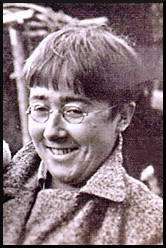Felicia Browne
Felicia Mary Browne (18 February 1904 – 25 August 1936) was an English artist and leftist. She was the first British volunteer to die in the Spanish Civil War.[1][2] Her body was not recovered.
Felicia Browne | |
|---|---|
 | |
| Born | 18 February 1904 |
| Died | 25 August 1936 (aged 32) Aragón, Spain |
| Nationality | British |
| Alma mater |
|
| Known for | Painting, political activism |
Early years
Felicia Browne was born at Weston Green, Thames Ditton, Surrey, on 18 February 1904.[3] She studied at the St John's Wood Art School and the Slade School of Art between 1920–21 and 1927–28. Arriving at the Slade at the unusually young age of 16, she was a contemporary of William Coldstream, Clive Branson, Claude Rogers and Nan Youngman.
She travelled to Berlin in 1928 to study metalwork and became an apprentice to a stonemason. She was living in Berlin during the rise of National Socialism and participated in anti-fascist activities.[2] One account describes her taking part in anti-Nazi street-fighting. In the early 1930s she returned to Britain, leaving her sculptures and tools behind. In 1933 she joined the Communist Party of Great Britain, attracting the interest of M15 and Special Branch who continued to monitor her until she left for Spain in 1936.[2]
She also became an active member of the Artists' International Association, and in 1934 she won a prize for her design of the Trade Union Congress Tolpuddle medal.[4] She contributed art to Left Review.[1]
Involvement in the Spanish Civil War
In July 1936 Browne embarked on a driving holiday to France and Spain, accompanied by her friend Dr Edith Bone, a left-wing photographer. Their objective was to reach Barcelona in time for the People's Olympiad (the Soviet response to the Olympic games in Hitler's Berlin). However, they arrived shortly before the military rebellion against the Spanish republic that heralded the start of the Spanish Civil War (1936–1939), and were immediately caught up in the violence that engulfed Barcelona on 19 July 1936. On 3 August 1936, after several attempts, she successfully enlisted in the PSUC (Catalan Communist) Karl Marx militia to fight in Aragon on the Zaragoza front.[5] According to the Daily Express correspondent Sydney Smith, she demanded to be enlisted to fight, declaring that "I am a member of the London Communists and I can fight as well as any man."[2] Shortly after joining she wrote to her friend Elizabeth Watson describing her desperation to get involved; "Apparently no chance of aviation school on account of my eyesight, God damn it."[6]
On 25 August 1936 Browne was killed in action on the Aragón front near Tardienta, while part of a band of raiders that attempted to dynamite a Nationalist munitions train. The party was itself ambushed and Browne was shot dead while assisting an injured Italian republican.[7] Browne's body had to be left there but her fellow soldiers retrieved a sketchbook from her possessions filled with drawings of her fellow soldiers. These made their way to Tom Wintringham, a journalist for the Daily Worker, who suggested to Harry Pollitt that they be sold by the Artists' International Association (AIA) to raise money for Spanish relief. The AIA presented Browne as being the epitome of an artist choosing to take direct political action.[8]
Her friend and colleague Nan Youngman, who was much affected by her death, organized her memorial exhibition in October 1936.
References
- Tom Buchanan, "The Lost Art of Felicia Browne", History Workshop Journal, Autumn 2002, (p. 180-201)
- Buchanan, Tom (2007). The Impact of the Spanish Civil War on Britain. Eastbourne: Sussex Academic Press. p. 66. ISBN 978-1-84519-127-6.
- Oxford Dictionary of National Biography
- Spartacus Educational
- Fraser, Pauline (February 2014). "Felicia Browne: first British casualty in Spain". International Journal Memorial Trust Newsletter.
- "Item: Letter from Felicia Browne to Elizabeth Watson | Tate". www.tate.org.uk. Retrieved 5 March 2016.
- E. Tofoni, Il lungo cammino nella Sierra, Ed. Lavoro, page 41
- Martin, Simon (2014). Conscience and Conflict: British Artists and the Spanish Civil War. Chichester: Pallant House Gallery. p. 38. ISBN 978-0-70780-429-3.